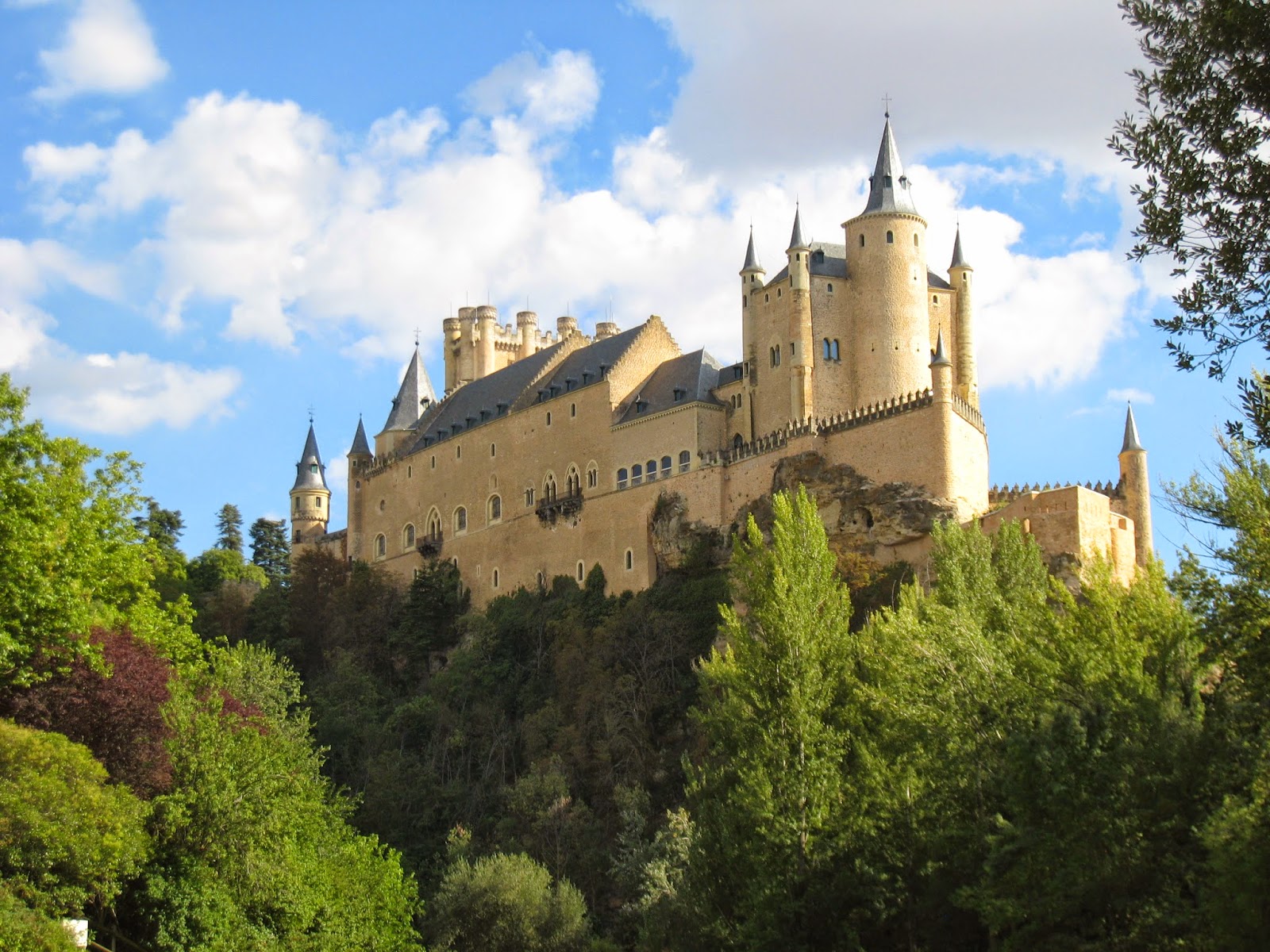I left Malaga reluctantly, but was soon glad that I
did. If I hadn’t continued on my travels
through Spain, I never would have discovered Segovia, which is my new favorite
place in Spain. I planned to stay for
three days and ended up staying for five! Segovia, in the Castilla y Leon
region northwest of Madrid is a world (ok, just a few hundred kilometers) away
from Malaga. The heart of life in
Segovia still takes places in and directly around the old city walls. A beautiful roman aqueduct, thousands of
years old, runs right through the historic center. Beautiful old churches and
monasteries abound. The Alcazar (castle)
is said to have been Walt Disney’s inspiration for the Beauty and the Beast
castle. Beautiful green mountains are visible in the distance. All of this
gives Segovia a sense of both magic and mystery. It’s a small city (pop.
50,000) so it’s very tranquil and surrounded by green spaces and two rivers. Also, the people are really friendly!
 |
| In front of the aqueduct |
When I arrived at my hostel, Blanca, who runs the hostel
along with her friend Guillermo, gave me a map and pointed out all the
highlights of the city. She mentioned
the location of a community garden and when I expressed interest in seeing it,
she told me she and her friends have a plot, and I was welcome walk there with
her if I wanted. And so my time in
Segovia began with a couple hours spent harvesting tomatoes and weeding garden
beds in the most beautifully situated community garden I’ve ever seen, below
the old city walls and irrigated by natural springs. Blanca pointed out to me
an edible weed and asked if I knew it, and I realized it was purslane, which
thanks to Martha in Silver City, I know is delicious. Apparently I was the only one interested in
eating it, so I created my own little purslane pile separate from the
weeds. Sauteed with onion and scrambled
eggs, it made a great meal the following day! After gardening, I walked with
Blanca and her friend Maria to a local bar en route to bring their veggies to
the hostel, carrying a bag overflowing with tomatoes on one arm and a stalk of
basil in my other hand. They told me I looked like a local and now I just
needed to learn one phrase to sound like one too – “¿Que paja (paha), maja (maha)?” Apparently Segovians says their “s” as a “j,”
which in Spanish sounds like the English “h.” So this phrase is actually “¿Que
pasa, maja?” to anyone outside of Segovia and basically translates to “how’s it
going, friend?” Armed with the magic
words, I waived my basil wand and POOF, Rachel transformed to Raquel, from
Segovia.
 |
| Segovia community garden (foreground) beneath the old city walls. |
Another day I took a long walk around the city, stopping
every 20-30 minutes to pick blackberries from the abundant bushes. If anyone every questions whether or not
blackberries are an invasive plant, I invite you to visit Segovia, where blackberry
branches climb up and over entire trees! When I left Germany I thought I had
said goodbye to berries for the season, so although the Spanish berries are
smaller and less juicy due to drought, this discovery was exciting. By the end
of my afternoon-long stroll, I’d gathered enough blackberries to munch on for
breakfast for the rest of the week. I also discovered on this walk, that the
Alcazar is best enjoyed by circling the city.
I’d visited it the day before and been unimpressed by the interior and
even the view from the front, but you just can’t beat this view from down
below.
 |
| No, this is not a movie set backdrop - it really does look this amazing. |
Other highlights included a visit to a monastery, the
massive palace gardens in a nearby town, a little museum about local cuisine,
and a guided tour of a local photography exhibit in which I was the only
non-native Spanish speaker, and I understood almost all of it! The old
pre-Inquisition Jewish cemetery is somewhat preserved and the historic Jewish
neighborhood still stands, although there’s little Jewish about it today other
than the names of a few restaurants. One
restaurant, the Judería, serves Indian food tapas, and they’re actually not
bad! How’s that for cultural fusion? A
tiny two-room museum about Sephardi Jews was unimpressive and not that
informative unless you know nothing about Judaism, but I’m looking forward to
my visit to the synagogue and museum in Toledo at the end of my trip.
Magically, in a region known for its grilled meat, I found several
vegetarian-friendly menus that also fit all my current dietary restrictions,
despite the fact that the actual vegetarian restaurant in town was closed
because the owners were on vacation. The aspect of Toledo I enjoyed the most
was the people. I had many nice
conversations with Blanca and Guillermo and their friends, as well as shop and
restaurant owners. At the end of my time
in Segovia, Blanca and Guillermo provided many suggestions for my travels in
northern Spain and even printed out a map of the narrow gauge railroad line
running across the northern coast. They
invited me to return for a longer stay and gave me my first night’s stay free
for helping in the garden plot, which was a rather unexpected and nice
surprise. I’ll definitely be returning there at the first opportunity I get.
No comments:
Post a Comment